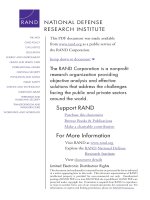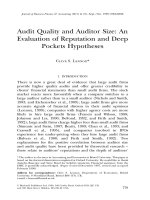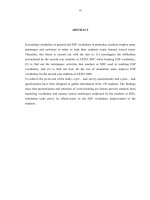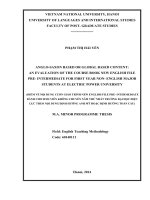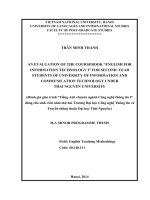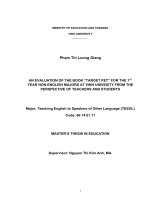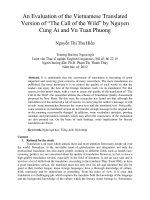An evaluation of the ESP course book for students of tourism and hospitality department at national economics university students’ perspective
Bạn đang xem bản rút gọn của tài liệu. Xem và tải ngay bản đầy đủ của tài liệu tại đây (1.71 MB, 204 trang )
VIETNAM NATIONAL UNIVERSITY, HANOI
UNIVERSITY OF LANGUAGES AND INTERNATIONAL STUDIES
FACULTY OF ENGLISH LANGUAGE TEACHER EDUCATION
GRADUATION PAPER
An Evaluation of the ESP Course Book for Students of
Tourism and Hospitality department at National
Economics University: Students’ perspective
Supervisor: Nguyễn Thụy Phương Lan, M.A.
Student: Bạch Hà Phương
Course: QH2017.F1.E2
HANOI - 2021
ĐẠI HỌC QUỐC GIA HÀ NỘI
TRƯỜNG ĐẠI HỌC NGOẠI NGỮ
KHOA SƯ PHẠM TIẾNG ANH
KHĨA LUẬN TỐT NGHIỆP
Đánh giá giáo trình tiếng Anh chuyên ngành cho sinh
viên khoa Du lịch và Khách sạn trường Đại học Kinh
Tế Quốc Dân từ quan điểm của sinh viên
Giáo viên hướng dẫn: Nguyễn Thụy Phương Lan, M.A.
Sinh viên: Bạch Hà Phương
Khóa: QH2017.F1.E2
HÀ NỘI - 2021
I hereby state that I: Bach Ha Phuong, being a candidate for the degree of Bachelor of
Arts (B.A honors) accept the requirements of the College relating to the retention and
use of Bachelor’s Graduation Paper deposited in the library.
In terms of these conditions, I agree that the origin of my paper deposited in the library
should be accessible for the purposes of study and research, in accordance with the
normal conditions established by the librarian for the care, loan or reproduction of the
paper.
Signature
Date
Acknowledgement
First and foremost, I would like to express my utmost gratitude to my supervisor,
Ms. Nguyen Thuy Phuong Lan (M.A), whose guidance and support have enabled me to
carry out the thesis. Her knowledge and valuable advice have deepened my
understanding of the topic and her encouragement has been a driving force for me to
complete the study with enthusiasm.
Second, I am grateful for all of the participants who have been generous to spend
their time and effort doing the survey and participating in the interview, especially Ms.
Nguyen Thi My Hanh (Ph.D), who has helped me contact with all of the participants of
the study and provided information about the ESP course at NEU. The study would not
have been carried out without their participation.
Third, I would like to send my appreciation to my family members who have
been encouraging me throughout the process.
Last, I wish to thank Hien Anh, Tam Nguyen and Ha Linh, my best friends at
ULIS for their constant encouragement and support. Even though the workload and
distance hindered us from interacting face-to-face, their messages and phone calls have
been more than enough to keep me motivated.
i
Abstract
Materials evaluation is essential in language learning and teaching process. This
study was carried out to investigate the strengths and weaknesses of the ESP course
book used for the Tourism and Hospitality Department at National Economics
University (NEU), as well as how the course book can be improved from the
perspectives of the students at NEU.
The data collection instruments used in this study were questionnaire and
interview. The questionnaire was distributed to second-year students currently
undergoing the ESP course at NEU. It is based on Hutchinson and Waters’ (1987)
framework for materials evaluation. The interview with the ESP teachers, second-year
students and first-year students were conducted to triangulate the data gathered from the
second-year students. The questionnaire looks into students’ perspectives about the
course book being used in terms of strengths and drawbacks in its aims, contents, and
methodology.
The results of the study showed the strengths as well as weaknesses of the course
book in those aspects. Overall, while the course book needs improvement in some
aspects such as the contents and methodology, it has many strong points which are
suitable for the learning context at NEU.
Key words: materials evaluation, English for Specific Purposes, students’
perspectives.
ii
List of tables
Table 1: Information of the interviewees
24
Table 2: Students’ judgement of their English proficiency
26
Table 3: Students’ needs for learning ESP based on the course’s objectives
26
Table 4: Students’ overall evaluation of the course book’s fulfilment of
the course objective
27
Table 5: Students’ opinions about how well the course book meets the
course objectives
28
Table 6: Students’ opinions about how well the course book meets the
course objectives
30
Table 7: Students’ opinions about the importance of the macro-skills
presented in the course book
32
Table 8: Students’ opinions about the macro skills presented in the
course book
33
Table 9: Students’ opinions about the importance of micro-skills
34
Table 10: Students’ opinions about the micro skills presented by the course book 35
Table 11: Students’ opinions about the importance of the language components
36
Table 12: Students’ opinions about the language components (grammar,
pronunciation and vocabulary) presented by the course book
37
Table 13: Students’ opinions about the relevance of the topics of each unit in
the course book
39
Table 14: Interviewees’ preferences of the topics in the course book
40
Table 15: Students’ opinions about the importance of the methodology
41
Table 16: Students’ opinions about the methodology presented in the course book 42
Table 17: Students’ suggestions in terms of the contents
43
Table 18: Students’ suggestions for the methodology
46
iii
List of acronyms
CEFR: Common European Framework for Reference
CLIL: Content and Language Integrated Learning
EAP: English for Academic Purposes
EFL: English as a Foreign Language
ELT: English Language Teaching
EOP: English for Occupational Purposes
ESL: English as a Second Language
ESP: English for specific purposes
EVP: English for Vocational Purposes
GE: General English
HaUI: Hanoi University of Industry
NEU: National Economics University
POHE: Profession - Oriented Higher Education
VESL: Vocational English as a Second Language
iv
TABLE OF CONTENT
Acknowledgement
i
Abstract
ii
List of tables
iii
List of acronyms
iv
Introduction
1
1. Research problems and rationale
1
2. Scope of study
2
3. Research aims and objectives
3
Chapter I: Literature review
4
1. An overview of ESP
4
1.1. Definition of ESP
4
1.2. Types of ESP
4
2. An overview of materials evaluation
5
2.1. The importance of course books in language teaching
5
2.2. Definition of materials evaluation
6
2.3. Materials evaluation based on perspectives
7
2.4. The importance of materials evaluation
8
3. A review of materials evaluation framework
10
3.1. Cunningsworth’s materials evaluation framework
10
3.2. Hutchinson and Waters’ materials evaluation framework
11
4. A review of precedent research
13
Chapter II: Methodology
16
1. Research questions revisited
16
2. Review of the context: ESP course at NEU
16
2.1. ESP course at NEU
16
2.2. Course book for English for tourism at NEU
18
3. Quantitative approach
19
v
4. Purposive sampling
20
5. Data collection instruments
20
5.1. Questionnaire
21
5.2. Interview
22
6. Data collection procedures
24
Chapter III: Findings and discussions
26
1. Students’ opinions about the course book
26
1.1. Students’ background
26
1.2. Students’ opinions about the suitability of the course book in terms
of aims and approaches
26
1.3. Students’ opinions about the suitability of the course book in terms
of the contents
30
1.3.1. Students’ opinions about the difficulty
30
1.3.2. Students’ opinions about the macro-skills
32
1.3.3. Students’ opinions about the micro-skills
34
1.3.4. Students’ opinions about the language components
36
1.3.5. Students’ opinions about the topics
38
1.4. Students’ opinions about the suitability of the course book in terms of
methodology
41
1.5. Additional opinions
43
2. Students’ suggestions for improvements of the course book
43
2.1. Students’ suggestions in terms of the contents
43
2.2. Students’ suggestions in terms of methodology
46
2.3. Other suggestions
47
3. Summary
47
Conclusions
50
1. Recapitulation
50
2. Limitations of the study
51
vi
3. Suggestions for further studies
51
References
I
Appendix 1
V
Appendix 2
XVII
Appendix 3
XXIX
Appendix 4
XXXI
Appendix 5
XXXIII
Appendix 6
XXXV
Appendix 7
XXXVII
Appendix 8
XXXIX
Appendix 9
XLI
Appendix 10
XLIX
Appendix 11
LX
Appendix 12
C
vii
Introduction
1. Research problems and rationale
English for specific purposes (ESP) is a movement which is continuously
growing more influence on the demand for using English for occupational purposes
(Purwanti, 2019; Hutchinson & Waters, 1987). Learning ESP for career-oriented tasks
has gained popularity on a global scale and has since attracted ESP specialists to design
ESP courses and programs in accordance with learners’ needs and career goals
(Hutchinson & Waters, 1987). ESP is now a very crucial part of English language
teaching (ELT) (Hutchinson & Waters, 1987) and is constantly undergoing development
to deal with the essential English skills based on learners’ professional background
(Purwanti, 2019).
To achieve the best outcomes for a subject, it is important that a course book be
used, especially for an ESP course. A course book contributes greatly in aiding teachers
and learners in the teaching-learning process and it can be used to achieve the course
objectives (Purwanti, 2019). Moreover, course books are crucial for language teaching,
so an evaluation is necessary for the material to be up-to-date with the contemporary
teaching programs and methods. Additionally, the process will not be complete without
a suitable course book, as stated by Hutchinson and Torres (1994).
Whether it be a commercial or compiled book, an evaluation of materials is a
vital process to decide how its suitability can be a driving force for students’ learning
motivation. Materials evaluation is a common process for language practitioners in order
to establish the suitability of the contents and the methodology used in the materials in
a specific context (Littlejohn, 1998). Furthermore, Tomlinson (2001) and
Cunningsworth (1995) suggested that evaluating and adapting materials is vital to ensure
that the materials can fulfill the course objectives and learners’ needs, since rarely can
any textbook be utilized for all situations. Therefore, course book evaluation is essential
as it can help the teachers select and adapt the materials according to their strengths and
weaknesses. Identifying the strengths enables the teachers to exploit the book to its
1
fullest extent, while identifying its weak points helps teachers improve, adapt or replace
the materials (Cunningsworth, 1995).
English has been regarded as an international language in Vietnam and it is
becoming increasingly important in several industries such as business, trade, economy
and tourism (Bach, 2015). Moreover, ESP has become a popular trend around the world
since 1960s and 1970s and it has become an established part of the curriculum in
Vietnam. ESP is among the main courses taught in most Vietnamese universities, whose
aim is to prepare students for their future professions. In 2019, the tourism sector in
Vietnam contributed approximately 9.2% to the country's GDP (Vietnam National
Administration of Tourism, 2019). Therefore, tourism is one of the leading industries in
Vietnam, so it is essential for the pre-service as well as in-service employees of this
industry to be familiar with one of the most used languages in the world. In addition,
since inter-cultural encounters are the norm in tourism and hospitality, English plays an
important part as a means of negotiation between tourists and employees (Bach, 2015).
For the students of the Tourism and Hospitality department at NEU, “English for
International Tourism: Intermediate Course book” by Dubicka and O’keeffe (2013) has
been used for the ESP course since 2020. While the topic of materials evaluation has
been previously investigated by precedent researchers, none has taken this particular
course book as the subject of evaluation, especially in Vietnam. Thus, this study will
contribute to the existing body of knowledge on ESP materials evaluation, and serve as
a reference for ESP specialists who want to use this course book for their ESP course.
2. Scope of study
The researcher aims to evaluate the course book “English for International
Tourism: Intermediate Course book” used for the ESP course from the perspectives of
full-time students at NEU in Hanoi, Vietnam. 83 students and two ESP teachers will be
the participants of this study. Specifically, the data is gathered from 79 second-year fulltime students who are undergoing the course, 4 first-year full-time students who are
2
going to take the course and 2 ESP teachers at NEU. The viewpoints from the students
will be the main focus of this study.
3. Research aims and objectives
This research aims to investigate the perceptions and attitudes of 79 full-time
students towards the course book that is used for studying English for Tourism at NEU.
The objectives of this study is to evaluate the course book in terms of:
●
its strengths and drawbacks from the students’ perspectives;
●
its shortcomings when compared with the objectives of the course;
●
suggestions for improvements as proposed by the students.
The ESP teachers were asked about the strengths, weaknesses and suggestions
for improvements in the interview.
To reach the aims and objectives of the study, the following research questions
are designed:
1. What are the strengths and weaknesses of the course book “English for
International Tourism: Intermediate Course book” as perceived by the students of the
Tourism and Hospitality Department at NEU?
2. What are the aspects of the course book “English for International Tourism:
Intermediate Course book” that should be improved as perceived by the students of the
Tourism and Hospitality Department at NEU?
3
Chapter I: Literature review
1. An overview of ESP
1.1. Definition of ESP
Since the 1960s, ESP has attracted many specialists and researchers’ attention
and become a prevalent area in the language teaching field (Hutchinson & Waters, 1987;
Ibrahim, 2010). In defining ESP, Hutchinson and Waters (1987) saw it as an approach
to language learning that centered its focus on learners’ needs, rather than a product or
a specific language or methodology. Mackay and Mountford (1978, p.2) also shared the
view that the purpose of ESP is decided by learners’ needs, whether it be for academic
or vocational purposes. Furthermore, ESP is also responsible for the development of
learners’ abilities that are needed in order for them to perform tasks in a particular field
or profession.
ESP is also referred to as the teaching and learning of English as a second
language (ESL) where English is used in a certain field by learners (Hutchinson &
Waters, 1987). Ibrahim (2010) added that the nature of the language, the learners and
the learning context are the three aspects of ESP that are closely connected to each other.
From that, he defined ESP as the teaching of specialized discourse in English in which
learners use it in a specific field. Specifically, ESP is viewed as a “goal directed kind of
language”, in which students learn and use English because there exists a need for its
practice in the working environment (Ibrahim, 2010). Because of the nature of ESP, all
decisions for the use of contents, teaching methodology, and curriculum of an ESP
course are determined by the learners’ reasons for learning.
In summary, while ESP can be viewed and defined in many ways, it is mostly
viewed as an approach to teaching based on learners’ needs.
1.2. Types of ESP
According to Hutchinson and Waters (1987), ESP includes teaching English for
any purposes (e.g. work or study) other than for test-taking purposes. They saw ESP as
a branch of ESL (English as a Second Language) or EFL (English as a Foreign
4
Language), where ESP is further broken down to two main types: English for Academic
Purposes (EAP), and English for Professional Purposes (EOP) (Hutchinson and Waters,
1987; Robinson, 1991). Other names for EOP include EVP (English for Vocational
Purposes) and VESL (Vocational English as a Second Language). As the name suggests,
EAP is taught for learners at academic institutions who want to learn English for their
academic study. Meanwhile, EOP is taught for those who use their knowledge of
language in their work or career training. With that classification, since the students of
the Tourism and Hospitality at NEU undergo the ESP course to use their language as
part of their career training, we can say that they learn EOP in their course.
2. An overview of materials evaluation
2.1. The importance of course books in language teaching.
To understand the importance of materials evaluation, first we must look into
what is defined as a material and its importance in ELT. “Materials” consist of the
equipment or tools used in the teaching-learning process. Furthermore, “they can be
linguistic, visual, auditory, or kinesthetic, and they can be presented in print, live
performance, or display or on cassette, CD-ROM, DVD or the Internet” (Tomlinson,
2001, p. 66). Therefore, a course book or textbook are also considered materials, so the
terms “course book”, “textbook” and “materials” will be used interchangeably
throughout this study.
Course books play an important role in language teaching as it can be a source of
activities to promote and encourage communicative purposes, a reference source for
learning language components and ideas for classroom activities, a syllabus or a support
for teachers with little experience (Cunningsworth, 1995). Nowadays, course books still
play a vital role in ELT classrooms and are still being widely used around the world
(Dendrinos, 1992; Lee, 1997; Williams, 1983). Since it is established that ESP is a
branch of ELT, it can be inferred that the use of course books is still prominent in ESP
context.
5
For Hutchinson and Torres (1994), course books can provide the learners with
security, system, progress and revision while being cost-effective. Furthermore, course
books serve as an aid to attain credibility and standardization. Meanwhile,
Cunningsworth (1995) noted that overdependence on course books would result in
severe constraints in flexibility and in reducing the importance of individual
contributions that teachers make during the learning process, making it not at all ideal.
Skehan (1998) also argued that the use of course books does not align all the notions of
learning centeredness since modifying the material according to learner differences is
very constrained. Nevertheless, Hutchinson and Waters (1987) argued that if a thorough
needs analysis is conducted and if students are able to negotiate the curriculum with the
teachers, then the teachers can make appropriate decisions to the materials such as what
to include or omit, making the materials relevant in the learning and teaching process.
Therefore, the chosen course book should be used selectively and aided with other
materials when necessary.
Overall, there is an agreement among researchers that course books are vital to
ELT. Given the educational context in Vietnamese schools and universities, course
books are regarded as a crucial element in the language learning and teaching process.
2.2. Definition of materials evaluation
Course books are used in classrooms around the world as a tool for instruction,
and they can influence the way the learning content is delivered to the students.
Therefore, it is of utmost importance to decide on the suitability of a course book. To do
so, a thorough evaluation of the material should be carried out.
Hutchinson and Waters (1987) defined evaluation as a process of judging the
suitability of something for a specific purpose, or a matching process between the needs
and the available solutions. Ultimately, evaluation is concerned with relative merit, in
which there only exists a certain level of suitability for the given purpose. When defining
materials evaluation, Cunningsworth (1995) and Tomlinson (1998) described it as the
process of analyzing the materials in terms of their strengths and weaknesses, which can
6
help instructors exploit the material to its fullest extent, or adapt it to be more suitable
to the learning and teaching context. For Brown (1989, p.231), course book evaluation
is a systematic process of collecting and analyzing the relevant aspects to make
improvements to the curriculum. In addition, course book evaluation also includes
examining the curriculum’s effectiveness and the participants’ opinions within the
context. The participants can be the teachers or students using the course book in a
learning-teaching context, so it can be inferred that investigating the students’
perspectives of a course book is an important part of the evaluation process.
In Cunningsworth’s study (1995), there are two approaches for evaluating a
material: impressionistic approach and in-depth approach. To ensure a good match
between the course books and the learning-teaching context, an impressionistic
overview will not be sufficient as it will not be able to examine the shortcomings of the
material (Cunningsworth, 1995). Furthermore, the impressionistic approach is receptive
since we only look for things in the material that it deemed interesting or relevant.
Rather, an in-depth evaluation is needed in order to examine more aspects of the course
books. By carrying out the in-depth approach, we are analyzing the information about
the materials that aligns with an already chosen agenda (Cunningsworth, 1995).
According to him, combining the two approaches will form a solid foundation for
evaluating and consequently selecting a suitable way to adopt the materials.
In summary, many researchers concluded that materials evaluation is the process
of giving judgement on the given material in terms of its strong points, shortcomings,
and suitability to the given learning and teaching situation. Based on those aspects,
necessary adjustments can be made so that it is more suitable to the curriculum and
learners’ needs.
2.3. Materials evaluation based on perspectives
Throughout the years, there has been a plethora of studies on materials evaluation
in ELT as well as ESP, many of which also investigate the materials based on the
perspectives of the users, such as teachers or students. Perspectives can be understood
7
as individual awareness and interpretation of the world based on personal experience
(Given, 2018). Therefore, having the experience from students, who are one of the most
important stakeholders in language learning, can contribute greatly to the changes and
adaptations that can be made for the learning and teaching process. Salehi, Khavidar and
Mehrabi’s research in 2015 focused on evaluating the ESP course book based on the
lecturers’ and learners’ perspectives. Their results showed that the instructors and
students have a positive view on the ESP course book. A study undertaken by Sari and
Sari (2019) also looked into evaluating the ESP course book from the perspectives of
teachers, cadets and graduates. Both studies used questionnaires and interviews as data
collection instruments to investigate the participants’ views on the course book. Aside
from these two studies, a large number of studies with similar topic of interest have been
carried out, which goes to show how important students’ and teachers’ perspectives are
when it comes to judging the strengths and weaknesses of a course book.
2.4. The importance of materials evaluation
According to Hutchinson and Waters (1987), there is no best or worst material,
but rather materials that can be suitable to a certain extent. Tomlinson (2001) also shared
the same viewpoint, stating that there is no course book suitable to any particular
context, so the teacher’s duty is to warrant the match between the learners and the used
materials by carrying out an evaluation of the materials. In doing so, the evaluation
results will serve as a reference for material designers and instructors to formulate a
more improved version, allowing them to apply a more appropriate teaching
methodology. Furthermore, before one can select a suitable course book, an evaluation
of the course book is a vital process (Ellis, 1997), as the selection of a suitable material
will be the foundation for the aims and objectives of a course or teaching program.
Additionally, it is important to have a suitable textbook that can meet learners’ needs
and fit the curriculum (Byrd, 2001; Hutchinson & Waters, 1987). Sheldon (1988) gave
two reasons to evaluate course books. First, it helps the teachers make a decision on an
appropriate course book. Second, a thorough evaluation of a course book could help the
8
teachers familiarize with its contents. By being familiar with the contents, the evaluators
could make optimum use of the book’s strong points and consider the drawbacks.
Cunningsworth (1995) shared the same view that identifying the strengths and
weaknesses is essential as the strong points can be fully optimized while the weaker
parts can be improved by adaptation or replacement.
Materials evaluation may also be beneficial to teachers’ training and career
development as it familiarizes them with a range of materials (Cunningsworth, 1995).
Evaluating materials can be a valuable experience for language instructors as they have
the chance to be exposed to different ELT or ESL (English as a Second Language)
materials, which can be of use for their career whenever they need to make a decision
about a material in the teaching-learning process.
Additionally, Hutchinson and Waters (1987) suggested several reasons to
conduct a materials evaluation. First, it is carried out in order to identify the effectiveness
of the used material in the classroom. Second, evaluating materials is conducted to
investigate the extent to which the materials fulfill the course objectives at the end of
the lesson. Third, it is also to examine how well the material allows students to achieve
the learning objectives by looking into the difficulty of the tasks and observing learners’
performance. Last, it is to identify whether the designs of the materials are ideal for a
syllabus.
As suggested by Cunningsworth (1995), despite students’ lack of knowledge in
ELT compared to the teachers, it is still important to explore their perspectives on the
usefulness of the course books. This is because they are the prime users of the materials,
and with carefully selected questions, useful feedback will be collected from the
learners.
Moreover, learners can have the opportunities to use the target knowledge to
achieve communicative purposes with the help of learning materials (Tomlinson, 1998).
This is particularly vital to ESP as many ESP courses apply communicative
methodology, and being competent in English can strengthen learners’ professional and
9
personal development (Hutchinson & Waters, 1987). Therefore, evaluating materials is
also crucial in ESP.
To sum up, materials evaluation plays a key role in ELT as well as ESP. The
reason for conducting an evaluation is to select a suitable material, as it becomes a basis
for devising a course’s aims and objectives. Furthermore, appropriate modifications can
be made to ensure the match between the material and the learners by conducting an
evaluation. Finally, the materials evaluation process contributes to the teachers’ or
language instructors’ training and career development, as it provides them with
experience on evaluating, selecting and modifying a material.
3. A review of materials evaluation framework
To evaluate the material, it is vital to have a set of criteria for materials
evaluation. According to Tomlinson (1998), criteria are used to decide on the aspects
that need evaluating, and defining those criteria is an important step of the evaluation
process before the process takes place. Until now, many scholars and researchers have
developed their sets of criteria to create a materials evaluation checklist or framework.
Among those frameworks, one of the most widely known and used frameworks are
Hutchinson and Waters’ (1987) and Cunningsworth’s (1995). Their frameworks will
also be the subject for review in this study.
3.1. Cunningsworth’s materials evaluation framework
The framework for materials evaluation and selection by Cunningsworth (1995)
consists of 8 criteria: aims and approaches, design and organization, language content,
skills, topics, methodology, teacher’s book, and practical considerations. Each criterion
is a section in which it is followed by a set of detailed questions for evaluation.
In comparison with Hutchinson and Waters’ framework (1987), both frameworks
quite resemble each other in some aspects such as the aims and approaches, content,
methodology and practical considerations (other criteria). The evaluation criteria such
as topics, skills, design and organization, language content and teachers’ books are all
covered in the content section in Hutchinson and Waters’ (1987) framework. However,
10
Cunningsworth’s framework (1995) does not examine who the material is intended for
or who the learners are.
3.2. Hutchinson and Waters’ materials evaluation framework
Hutchinson and Waters (1987) identified four stages in the process of materials
evaluation: defining criteria, subjective analysis, objective analysis and matching.
The first stage: defining criteria is where one provides a list of criteria to evaluate
the material. Those criteria focus on the foundation in which one will judge the material,
and decide which criteria is more prominent.
Subjective analysis involves the teachers’ opinions and feelings about the
material and which criteria one wants to include in their course. Objective analysis takes
into consideration how well the materials can realize those criteria. In this stage, one
should not take into account any subjective views.
The final stage, which is the matching stage, helps the evaluator decide how well
the material meets their needs.
Hutchinson and Waters’ (1987) framework for materials evaluation includes both
subjective analysis and objective analysis. The subjective analysis analyzes the course
in terms of material requirements, while the objective analysis frameworks analyzes the
material under evaluation. The criteria for evaluation relates to the audience, the aims
and objectives, the content, the methodology, and other criteria (such as the cost and the
availability of the material).
Audience: The evaluator gains information about the learners regarding their
personal information, educational backgrounds, knowledge of English, and their
interests to examine the materials’ compatibility with the learners.
Aims: To examine whether the aims of the materials can satisfy the aims and
objectives of the course.
Content: In order to evaluate the materials’ suitability, the evaluator should look
into the aspects of the materials’ content such as: language descriptions, language points,
macro-skills, micro-skills, text-types, subject-matter areas, content organization and
11
sequencing and compare them with the requirements of the language course. In this
study, macro-skills will be referred to as listening, speaking, reading and writing skills,
and the micro-skills are the set of skills that help learners achieve the macro-skills, such
as deducting unfamiliar words, starting or maintaining a discourse and so on.
Methodology: This criterion helps the evaluator measure how effective the
methodology in the materials are for the students. The criterion includes examining the
learning theory the course is based on, learners’ attitudes or expectations, kinds of
exercises or tasks, teaching-learning techniques, available aids, guidance or support for
the teaching process, and flexibility.
Other criteria: When selecting a material, several practical considerations should
be looked into such as the price range and the availability of the material.
This framework has been used in previous studies concerning the evaluation of
ESP materials, course books or textbooks, such as Nguyen (2015), Ha (2016) and
Nguyen (2013).
When compared to Hutchinson and Waters’ framework (1987), most of the items
in Cunningsworth’s framework (1995) focus on objective analysis, which includes
examining the materials being evaluated and not the material requirements based on the
course. Furthermore, since this study aims to evaluate the course book “English for
International Tourism: Intermediate Course book” based on students’ perspectives,
these sets of questions may not be adequate to serve that purpose.
There exist many frameworks for evaluating materials, and in this study,
Hutchinson and Waters’ (1987) framework will be selected to evaluate the course book
“English for International Tourism: Intermediate Course book” that is used for the ESP
course in the Tourism and Hospitality department at NEU as it can answer research
questions of this study in greater detail. Their framework can deal with the shortcomings
of Cunningsworth’s framework (1995) by providing a fuller and more detailed outline
of a materials evaluation framework as it examines both the objective and subjective
view. The framework is also able to provide more information regarding learners’ view
12
of the course book, something that Cunningsworth’ s framework (1995) may not be able
to achieve as well as Hutchinson and Waters’ (1987).
4. A review of precedent research
A number of studies have contributed to the topic of ESP course book or materials
evaluation, among those are the studies conducted by Suhirman (2018), Baleghizadeh
and Rahimi (2011), Nguyen (2015), Ha (2016), and Nguyen (2013).
Suhirman (2018) conducted a study evaluating an ESP textbook and was able to
present a thorough analysis on the importance of books in an ELT or ESP context.
However, the research was lacking in several aspects. Firstly, the researcher did not
carry out the evaluation process based on a materials evaluation framework, but rather
on observation through reading the textbook. Secondly, no other instruments other than
the questionnaire was used to collect data from the participants. While the questionnaire
holds many merits to the researcher regarding its convenience, it might not help the
researcher gather more in-depth knowledge from the participants. Moreover, 21
participants might not be enough to draw a conclusion from the collected data
(Suhirman, 2018).
A strong point of Baleghizadeh and Rahimi’s study (2011) was that the reliability
of the questionnaire was tested using Cronbach Alpha, and the result of which was 0.76,
which indicates that the questionnaire is reliable. However, similar to Suhirman (2018),
Baleghizadeh and Rahimi (2011) also used a questionnaire as the only instrument to
collect information from the participants. Furthermore, while Suhirman (2018) was able
to collect data from both students and teachers, Baleghizadeh and Rahimi (2011) only
investigated the opinions from students, meaning the research lacked the opinions from
the experts of the field.
Nguyen conducted a study in 2015 in Vietnam about evaluating materials for
English for tourism, but at a different university - Hanoi University of Industry (HaUI).
Nguyen (2015) along with Ha (2016) and Nguyen (2013), also employed questionnaires
for the students and interviews for the teachers as data collection instruments. By having
13
the students and teachers as the participants, the researchers can triangulate the
information collected from different types of participants. Additionally, Nguyen (2015)
not only carried out the interview for the English teachers, she also interviewed the
teachers of the tourism department at HaUI. The questionnaire collected data about
students’ opinions on the material’s aims, contents, methodology and suggestions for
improvements. A strong point about Nguyen’s (2015) is that the researcher included
open-ended questions so that students would have more freedom in sharing their
perspectives. About 58 students participated in the study, while being slightly more in
number compared to Suhirman (2018), the number of participants might not be
representative enough.
Ha (2016) evaluated the material used by the nursing students at Quang Ninh
Medical College. Ha’s (2016) study is thorough in that the researcher collected data by
giving questionnaires and interviews to both the students and teachers. Unlike Nguyen
(2015), Ha (2016) does not enquire about the participants’ suggestions for the material,
but rather gives her own recommendation for the changes of the course book.
Viewpoints from a researcher and language practitioner may be useful in providing a
different look on the course book outside its users. However, Ha’s study (2016) could
benefit from including participants’ perspectives on what should be changed about the
book first before giving her own interpretation.
Nguyen’s (2013) study is about the evaluation of the material used at Hanoi
University of Mining and Geology for the economics and business management
students. While Nguyen (2013) included teachers’ and students’ input on the
recommendations for improvements in the questionnaire, the questions are 4 closeended items which address the necessity of the supplementary material for the four
macro-skills. Although Nguyen’s (2013) suggestions and interpretation are more indepth, the researcher should also design the questionnaire in a way that can gather more
data on the participants’ input on the suggestions for the course book.
14
Overall, it can be seen that the primary data collection instrument for the
aforementioned studies are questionnaires and/ or interviews, and the data is mostly
gathered from the students and/ or teachers. Most of the studies evaluated the materials
based on Hutchinson and Waters’ (1987) materials evaluation framework. Additionally,
several studies pointed out their shortcomings in the insufficient number of participants,
which will leave room for further studies in evaluating ESP materials.
15
